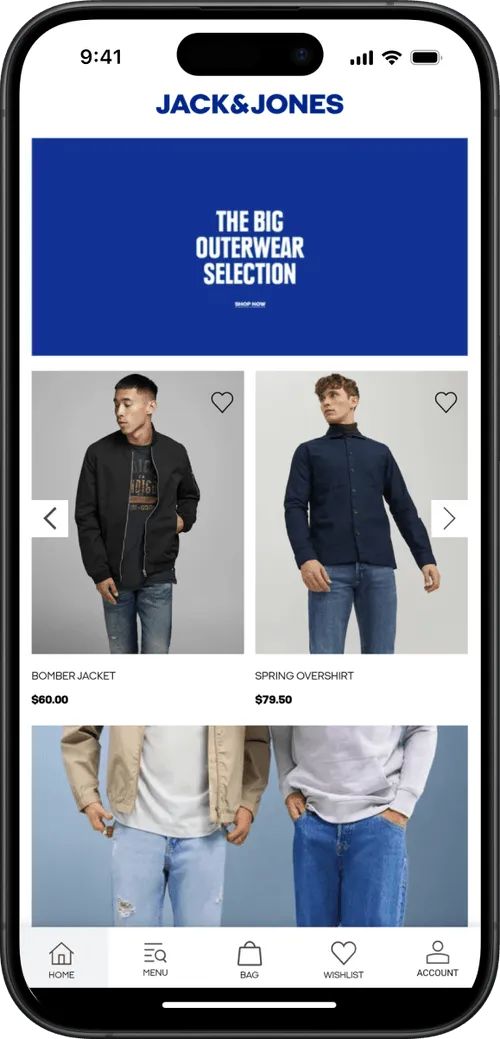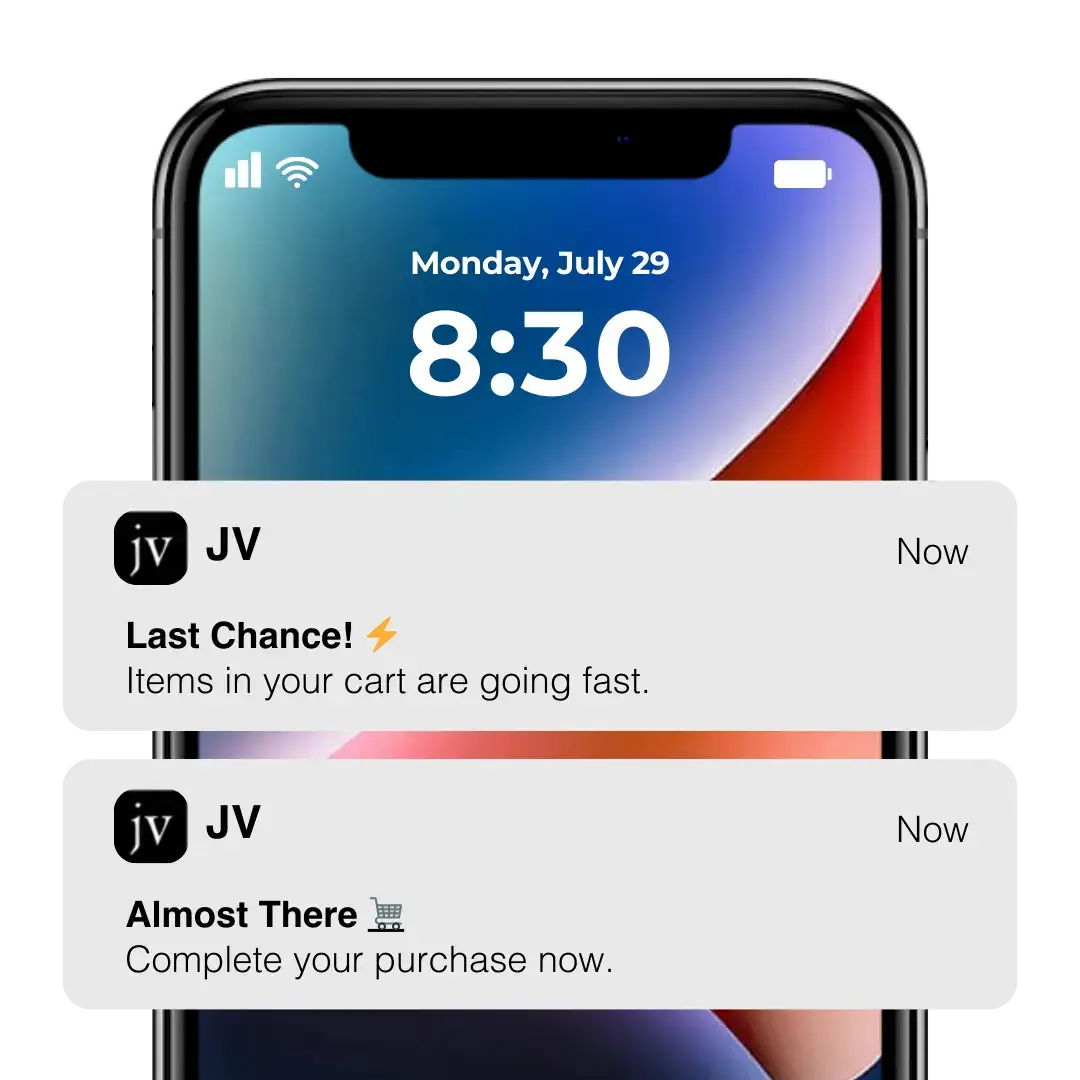6 Ways to Send Personalized Push Notifications (Plus Best Practices)
- Personalizing your push notifications is a great way to generate higher engagement and deeper loyalty for your brand.
- Consumers want to see relevant, personalized content, and push notifications are uniquely positioned to help you do this.
- Adding customers' names in your messages is a start, but for deeper personalization, consider sending custom product recommendations and event-triggered messages like abandoned cart notifications.
- Personalizing your push notifications is a great way to generate higher engagement and deeper loyalty for your brand.
- Consumers want to see relevant, personalized content, and push notifications are uniquely positioned to help you do this.
- Adding customers' names in your messages is a start, but for deeper personalization, consider sending custom product recommendations and event-triggered messages like abandoned cart notifications.
One of the best aspects of push notifications for marketers is how easy it is to set up unique, personalized communications.
It’s long been known that personalization has a huge impact on the success of marketing campaigns. Brands that send relevant and unique messages to their customers are typically going to see significantly better results than those whose content is broad and generic.
Keep reading and we’ll explain how you can start injecting more personalization into your push campaigns, including some best practices to follow, and some examples of personalized push notification campaigns your brand can start using today.
What is Personalization?
What do we mean when we talk about personalization?
Personalization means tailoring your content and your communications to each user individually.
Personalization can come from demographics, behavior, location, engagement level, or many other factors.
While it’s unrealistic for brands to compose completely unique and personal messages and promotions for every single customer, by using elements of personalization, you can make your customers feel more like they’re receiving a message that was crafted just for them, rather than making them feel like they’re just another recipient of a mass-marketing campaign.
Doing this can make a big difference for your brand, as we’ll explain next.
Why Personalization Matters
Research from McKinsey shows that companies who excel at personalization generate 40% more revenue on average.
When it comes to push notifications, personalized content has been shown to deliver 4x higher reaction rates, while personalized targeting and segmentation results in 3x higher retention rates.
Imagine you go into a coffee shop.
In one case, the cashier greets you with a generic “hello”, then offers you a discount on a drink you don’t want.
In another, you’re greeted with a personalized greeting, using your name, and offers you a 25% discount on the croissant you had your eye on, and your favorite coffee order.
You’re much more likely to come back to the coffee shop from the second example.
Yet brands are still acting more like the first example, with generic messaging and irrelevant content that drives customers away.
Those brands who are able to make their customers feel special and unique, and who serve more relevant content and promotions, will see much better ROI and long-term impact from their marketing, especially as consumers come to expect a higher standard of personalization in digital marketing.
Best Practices for Personalizing Push Notifications
While smart personalization can produce amazing results in your push notification campaigns, lazy execution or simple mistakes can end up being much worse than sending a generic message to your whole user base.
Here are some best practices to follow to help maximize the effectiveness of your personalized push notifications, and avoid some killer mistakes.
Use customers’ names
The simplest way to add a bit of personalization to your push notifications is by using your customers’ names.
Instead of:
“Hi, get 50% off all products this weekend only!”
Say:
“Hi Andrew, get 50% off all products this weekend only!”
Assuming you have your customers’ names, this is the ultimate low-hanging fruit of personalization.
You don’t need to do anything complicated to implement this – just use a merge field to dynamically switch the name in each message to the recipient’s.
People love hearing (or reading) their name, and this seemingly small touch will usually have a significant positive impact.
Use placeholder default values
Using your customer’s name is great, but it’s not so great when someone receives a message like:
“Hi {customer name}, have you seen our new product release?”
This has the opposite effect, tearing down the fourth wall and making it clear to the user that they’re part of an automated marketing campaign – and that you don’t care enough to get it right.
Whenever you have a merge field like this, set a default value in case you don’t have the user’s name on file, so it sends a generic “Hi” or “Hey there,” instead of actually displaying code in the message.
Make sure your messages turn out as intended
Before you set your campaign live, test it by sending a message to yourself, or to a dummy user.
You want to make sure it comes out as you intended it, with merge tags working correctly, and no awkward issues you didn’t expect.
Take this example from this article by OneSignal:

It’s worth the time and effort to spend a little longer thinking about how your message will turn out, to avoid making mistakes that make you look bad or offend the user, which could result in them unsubscribing from notifications.
Avoid over-personalization
Make your messages relevant and personal to the recipient, but it can get creepy and intrusive if you take it too far.
Avoid calling out very personal details about your customers, or suggesting they have interests in potentially sensitive topics.
It’s a balancing act – you don’t want the recipient of your push notifications to feel like they’re getting a generic mass-marketing campaign, but you don’t want them to feel like your app is watching everything they do either.
Test different approaches
There are many ways to personalize your campaigns, such as creating different demographic or interest segments, then sending different copy and creative to each segment, or sending messages to each segment at different times.
There are endless possibilities, and the only way to truly know what works best with your customers is to test and find out for yourself.
Constantly test and track the performance of different approaches, like specific segments and the type of notifications you send to each segment. After a while, you’ll start to put together a playbook that contains all the best practices unique to your audience.
6 Ways to Use Personalization With Your Push Campaigns
Want to start personalizing your push campaigns, but not sure where to start outside of just adding your user’s name?
We’ve got you covered. Here are six personalized push notification campaign ideas you can take and use to drive sales and engagement for your brand.
Abandoned Cart Notifications

Any brand with an app should be using abandoned cart notifications.
On average, 70% of eCommerce shopping carts are left abandoned. What’s worse, this rises to 86.7% on mobile.
The good part is that this means there’s a big opportunity to get more sales by going after the low-hanging fruit – people who have already added a product to their cart.
It’s much easier to follow up with these shoppers and get them to complete their purchase than to attract a new customer, as they’ve already shown significant intent, and they’ve let you know what product(s) they’re interested in.
An automated abandoned cart campaign won’t recover every single cart, but it will likely generate a significant boost to your sales, for little to no effort once implemented.
Browse Abandonment

Similar to an abandoned cart workflow, you can reach out to users who have spent a significant time browsing, but left without buying something or adding a product to their cart.
This is particularly effective if they’ve spent a long time on a specific product page, or browsing products in a specific category.
A push notification, triggered at the right time, may be just enough to get the user to come back and buy the product they had their eye on.
Personalized Product Recommendations

Use the data you have on your users to send them product recommendations tailored to their interests.
If they have a purchase history with you, or you have data on what kind of products they usually browse, you can personalize your communications to align with their interests.
Loyalty Campaigns

Make customers feel like a valued part of your business by calling out and thanking them for their loyalty.
Whether you have a points-based loyalty program, and you send push notifications updating them of their accrued points total, or you send a periodic “thank you” notification with an exclusive offer for regular customers, this is a great way to make your customers feel like they’re seen as a real person, and not just a number.
Birthday/Milestone/Event Offers

You could also send personalized offers to customers on special occasions.
If you have their birthday, this is an easy win. You could also send an offer to people on the anniversary of their first purchase with you (tying again into the loyalty angle), or product recommendations/offers around special occasions (like father’s day or mother’s day), especially if the user has a history of buying around this time.
Re-Engagement Notifications
Finally, re-engagement campaigns are a simple, yet effective way to bring back users who haven’t shopped in a while.
Set up an automated message like “We haven’t seen you in a while! How about checking out our new range of {personalized recommendation}”, triggered after the user has been inactive for a specific length of time.
You could couple it with a personalized discount as a sweetener to get the customer to come back and start shopping again.
Small, period touches like this can go a long way in terms of keeping your brand in your customers’ mind, and building more long-term engagement and value.
Check out more examples and best practices of push notifications for eCommerce brands in our Ultimate Guide.
Start Sending High-Impact, Personalized Push Notifications Now
To start reaping the benefits of personalized push notifications, you’ll need two things.
One, you’ll need a push notification service, such as OneSignal or Klaviyo, that makes it easy to segment your users and set up custom triggers and automated push notification campaigns.
Two, you’ll need a mobile app, to make it easy to integrate push notifications into your customer experience.
If you don’t have an app yet, MobiLoud is the solution for you.
Our done-for-you website to app service is an easy, cost-effective and sustainable way for brands to launch an app.
We take everything that already works on your website, and convert it into apps that look and feel great on both Android and iOS.
Your apps will have push notifications built in, out of the box, ready for you to start driving sales.

To learn more, check out some of the other high-revenue brands we’ve worked with, helping to build apps that deliver consistent value with minimal overhead.
If you’re ready to discuss how we can do the same for your brand, get in touch and book a free demo now.
FAQs
Convert your website into a mobile app












